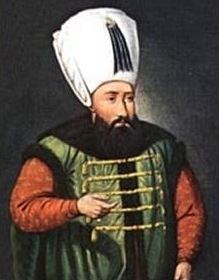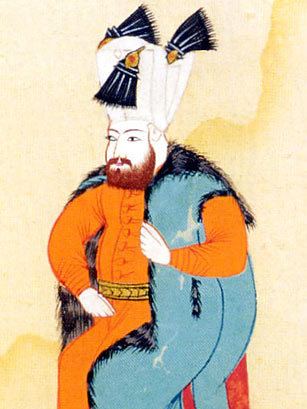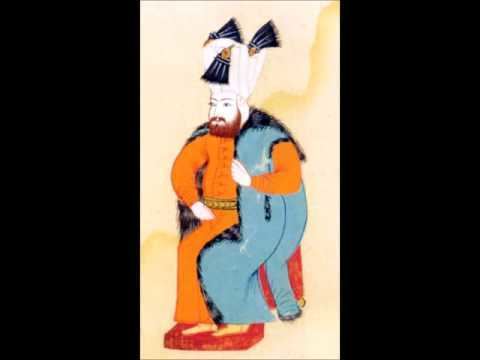Died August 18, 1648 | Royal house House of Osman Parents Kosem Sultan, Ahmed I Name Ibrahim the | |
 | ||
Reign 9 February 1640 – 12 August 1648 Consorts Humasah SultanTurhan SultanDilasub SultanMuazzez SultanAyse SultanMahienver SultanSivekar SultanSacbagli Sultan Issue Mehmed IVSuleiman IIAhmed IIUmmu Gulsum SultanPeykan SultanAtike SultanAyse SultanGevherhan Sultan Siblings Murad IV, Shahzade Kasim, Shahzade Suleiman, Ayse Sultan Spouse Humasah Sultan (m. 1647), Saliha Dilasub Sultan Children Mehmed IV, Suleiman II, Ahmed II, Atike Sultan, Peykan Sultan, Ayse Sultan, Gevherhan Sultan Similar People | ||
Ibrahim (Ottoman Turkish: ابراهيم, Turkish: İbrahim; 5 November 1615 – 18 August 1648) was the Sultan of the Ottoman Empire from 1640 until 1648. He was born in Constantinople the son of Ahmed I by Valide Kösem Sultan, an ethnic Greek originally named Anastasia. He was later called Ibrahim the Mad (Turkish: Deli İbrahim) by twentieth century historians due to his reputed mental condition.
Contents
- Early life
- Early years in power
- Decadence and crisis
- Deposition and execution
- Consorts
- Sons
- Daughters
- References
Early life

Ibrahim was born on 5 November 1615, the son of Sultan Ahmed I and his favorite concubine Kösem Sultan. When Ibrahim was 2, his father suddenly died, and Ibrahim's uncle Mustafa I became the new sultan. By that time, Kosem Sultan and her children, including young Ibrahim had been sent to the Old Palace. After the succession of his brother Murad IV, Ibrahim was confined in the Kafes, which affected his health. Ibrahim's other brothers Şehzade Bayezid, Şehzade Suleiman and Şehzade Kasım had been executed by the order of Sultan Murad IV, and because of that Ibrahim feared that he was next in the line. However, after his brother's death, Ibrahim became the Sultan of the Ottoman Empire.
Early years in power

One of the most notorious Ottoman Sultans, Ibrahim spent all of his early life in the close confinement of the Kafes before succeeding his brother Murad IV (1623–40) in 1640. Three of his brothers had been executed by Murad, and Ibrahim lived in terror of being the next to die. His life was only saved by the intercession of Kösem Sultan, mother of Ibrahim and Murad.

After Murad's death, Ibrahim was left the sole surviving prince of the dynasty. Upon being asked by Grand Vizier Kemankeş Kara Mustafa Pasha to assume the Sultanate, Ibrahim suspected Murad was still alive and plotting to trap him. It took the combined persuasion of Kösem and the Grand Vizier, and personal examination of his brother's dead body, to make Ibrahim accept the throne.

Ḳara Muṣṭafā Pasha remained as Grand Vizier during the first four years of Ibrahim’s reign, keeping the Empire stable. With the treaty of Szön (15 March 1642) he renewed peace with Austria and during the same year recovered Azov from the Cossacks. Ḳara Muṣṭafā also stabilized the currency with coinage reform, sought to stabilize the economy with a new land-survey, reduced the number of Janissaries, removed non-contributing members from the state payrolls, and curbed the power of disobedient provincial governors. During these years, Ibrahim showed concern with properly ruling the empire, as shown in his handwritten communications with the Grand Vizier. Ḳara Muṣṭafā in turn wrote a memo on public affairs to coach his inexperienced master. Ibrahim’s replies to Ḳara Muṣṭafā's reports show he had actually received a good education. Ibrahim often traveled in disguise, inspecting the markets of Istanbul and ordering the Grand Vizier to correct any problems he observed.
Decadence and crisis
Ibrahim was often distracted by recurring headaches and attacks of physical weakness, perhaps caused by the trauma of his early years. Since he was the only surviving male member of the Ottoman dynasty, Ibrahim was encouraged by his mother Kösem Sultan to distract himself with harem girls and soon fathered three future sultans: Mehmed IV, Suleyman II and Aḥmed II. The distractions of the harem allowed Kösem Sultan to gain power and rule in his name, yet even she fell victim to the Sultan's disfavor and left the Imperial Palace.
Ibrahim came under the influence of favorite harem ladies such as mistress of the imperial harem Şekerpare Hatun and the charlatan Cinci Hoca, who pretended to cure the Sultan's physical ailments. The latter, along with his allies Silahdar Yusuf Agha and Sultanzade Mehmed Pasha, enriched themselves with bribes and eventually usurped enough power to secure the execution of Grand Vizier Ḳara Muṣṭafā. Cinci Hoca became Kadiasker (High Judge) of Anatolia, Yusuf Agha was made Kapudan Pasha (Grand Admiral) and Sultanzade Mehmed became Grand Vizier.
In 1644, Maltese corsairs seized a ship carrying high-status pilgrims to Mecca. Since the pirates had docked in Crete, Kapudan Yusuf Pasha encouraged Ibrahim to invade the island. This began a long war with Venice that lasted 24 years—Crete would not completely fall under Ottoman domination until 1669. In spite of the decline of La Serenissima, Venetian ships won victories throughout the Aegean, capturing Tenedos (1646) and blockading the Dardanelles. Kapudan Yusuf enjoyed temporary success in conquering Canea, starting a jealous rivalry with the Grand Vizier that led to his execution (January 1646) and the Grand Vizier's deposition (December 1645).
With his cronies in power, Ibrahim's extravagant tendencies went unchecked. He raised eight concubines to the favored position of haseki (royal consort), granting each riches and land. After legally marrying the concubine Telli Haseki, he ordered the palace of Ibrahim Pasha to be carpeted in sable furs and given to her.
Deposition and execution
Mass discontent was caused by the Venetian blockade of the Dardanelles—which created scarcities in the capital—and the imposition of heavy taxes during a war economy to pay for Ibrahim's whims. In 1647 the Grand Vizier Salih Pasha, Kösem Sultan, and the şeyhülislam Abdürrahim Efendi unsuccessfully plotted to depose the sultan and replace him with one of his sons. Salih Pasha was executed and Kösem Sultan was exiled from the harem.
The next year the Janissaries and members of the ulema revolted. On 8 August 1648, corrupt Grand Vizier Aḥmed Pasha was strangled and torn to shreds by an angry mob, gaining the posthumous nickname "Hezarpare" ("thousand pieces"). On the same day, Ibrahim was seized and imprisoned in Topkapı Palace. Kösem gave consent to her son's fall, saying "In the end he will leave neither you nor me alive. We will lose control of the government. The whole society is in ruins. Have him removed from the throne immediately."
Ibrahim's six-year-old son Meḥmed was made Sultan. The new Grand Vizier, Ṣofu Meḥmed Pasha, petitioned the Sheikh ul-Islam for a fatwā sanctioning Ibrahim's execution. It was granted, with the message "if there are two Caliphs, kill one of them." Kösem also gave her consent. Two executioners were sent for; one being the chief executioner who served under Ibrahim. As officials watched from a palace window, Ibrahim was strangled on 18 August 1648. His became the second regicide in the history of the Ottoman Empire.
Consorts
All of Ibrahim's Hasekis received 1,000 aspers a day except for Aşub Sultan who received 1,300 aspers a day. Ibrahim gifted the incomes of Bolu, Hamid, Nicopolis Sanjaks, and Syria Eyalet to Aşub, Mahienver, Saçbağı, and Şivekar Sultans respectively. He also lavished the treasury of Egypt upon Saçbağı and Hümaşah Sultans, and presented the Ibrahim Pasha Palace to Hümaşah. His consorts were:
Sons
Daughters
At one point Ibrahim took a great liking to the infant son of a slave woman, to the extent of preferring the unrelated child to his son Mehmed. Turhan, Mehmed's mother, grew extremely jealous and vented her anger to Ibrahim, who flew into a rage and grabbed Mehmed from Turhan's arms and threw him into a pool. Mehmed would have drowned if a servant had not rescued him. He was left with a permanent scar on his forehead.
